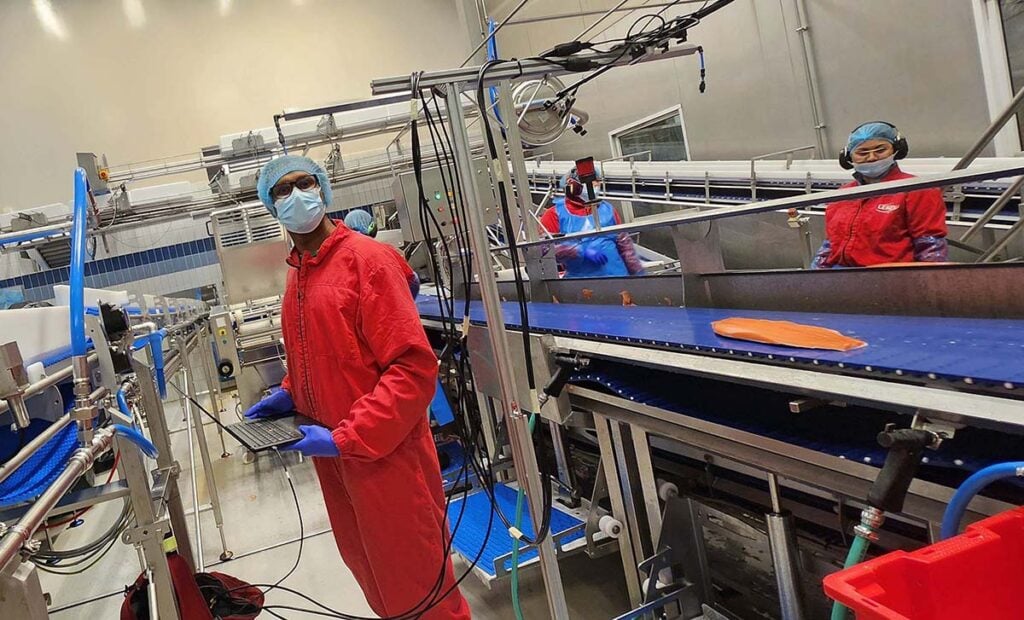The robot is equipped with “eyes” that assess the quality of the salmon. This allows it to sort out the best fillets.

The biggest challenge in deploying robots at the fillet factory is space constraints.
“Space limitations are a key factor. The processing line has very little room, so it requires a compact and efficient solution,” explains Antonio Candea Leite.
Robot with a Sensor
Leite is an associate professor at NMBU, where he leads the RoboSense team in SFI DigiFoods. Together with postdoctoral researcher Abhaya Pal Singh and research engineer Michael Angelo Amith Fenelon, he is developing better robotic solutions for the factory’s production line
Their approach is to combine sensors with robots. “Many sensors available on the market today would require manual operation by industry operators to scan the salmon. Robots can move much more efficiently and precisely. For humans, this is heavy and strenuous work. Robots, on the other hand, can work 24 hours a day without complaining,” Leite notes.
Tight and Humid Conditions
The researchers have visited Lerøy Aurora in Skjervøy to see how robots can be used in a real industrial setting.
“This way, we can see how the industry operates. Our goal is to examine how the RoboSense project can be integrated into the factory’s operations,” says Abhaya Pal Singh.
He points out that in addition to the tight space in a fillet factory, the environment is also humid. This means that developing new technology is not enough—it must also withstand the conditions in which it operates.
Checking Quality
“Our goal is to integrate a sensor into the robot arm. It can be any type of sensor, but in our case, we are using a Raman sensor,” says Michael Angelo Amith Fenelon.
This type of sensor uses spectroscopy—analyzing colors and chemical composition.
Initially, the researchers are using the a Raman sensor to determine the omega-3 content in salmon fillets.
“If the sensor becomes part of the factory’s production line, we can grade the fish based on quality. The challenge is that we must scan a specific area of the fish,” explains Fenelon.
The sensor must locate the belly of the fish, where the omega-3 content is highest, while the fish moves rapidly along the conveyor belt.
Detecting Spots
“We integrate a camera with artificial intelligence models that identify the belly. Then, the robot starts its work. It moves down to the fish and follows the belly without touching it. While doing so, it records a spectrum that can be used to sort the fillet by quality,” says Leite.
So far, the researchers have used AI models to detect melanin spots—the black spots in salmon fillets that cause significant losses in the aquaculture industry. “These spots are not harmful, and they do not make the fillets inedible, but consumers do not want them,” he states.
Needs to Be Faster
The main challenge now is that the conveyor belt moves too fast. The salmon fillets can travel through the production line at a speed of 40 centimeters per second. “Our solution can handle 20 centimeters per second. Other robots can move very quickly, but we still have some work to do to reach that level,” says Antonio Candea Leite.
Next step, the researchers will use the robot to scan around 1,000 salmon fillets at NMBU. They will then compare the quality of the scan results with those obtained manually by a human operator. “This will be our first real test,” he states.
Currently, an operator must manually start the Raman sensor. The goal is to fully integrate it into the robotic system so that it operates independently and automatically. The ultimate objective is to refine the solution to a point where it can be practically implemented in the industry.
